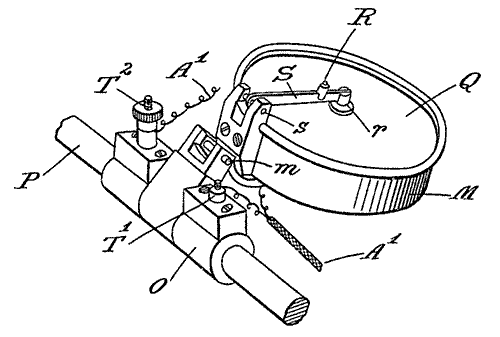
Version: Dec. 8, 2003
 |
|
Version: Dec. 8, 2003 |

|
This very early electric reproducer forms part of a patent filed by Augustus Rosenberg in 1909. The patent is not really for a cylinder player at all, but for a device to train the deaf and hard of hearing to hear again, much in the same way as François Dussaud in his earlier work. The claims in the patent are almost exclusively focused on the earplug that was to produce the strong vibrations Rosenberg thought needed to produce the desired effect. The choice of a cylinder phonograph as source of the vibrations was made because he wanted the strongest possible current to enter the earplug. This ruled out soundwaves in the air, although the device chosen to serve as pickup was actually a carbon microphone (M in the figures), a well known technology already used for decades in telephones. Less well known at the time was the vacuum tube, which could have provided any needed amplification. It had been invented in 1906, but was still not widely used. However, resorting to the technology at hand, Rosenberg actually managed to produce an amplification. A carbon microphone is really a variable resistor, that changes its resistance with the vibration of the thin membrane constituting one of its sides. A direct current is passed through the microphone, which modulates it, just like what is happening in a vacuum tube, or in our days, a transistor. So in fact the electric current was driven by the batteries in the circuit. Rosenberg called this microphone a "sound-controlled current regulator" or transmitter. He thought that in order to help the hearing impaired, they needed to hear a great variety of voices and music, not just any noise. A phonograph would be a practical source of such sounds, but he also mentions the possibility of using a musical box or automatic piano as a source of vibrations. Going on from where the patent stops, Rosenberg's transmitter could also have been used for replaying cylinders over the telephone network or to make a larger membrane vibrate so as to let several listeners at once hear the signal - a loudspeaker. It is not known to me if Rosenberg's invention was ever built or marketed. It does seem likely, however, that at some later time someone somewhere would have independently come up with the idea to equip a phonograph with a carbon microphone and fed the signal to a wireless set for amplification. Christer Hamp, 2003 |

Source: U.S. Patent 1,057,279

| If you know anything about Rosenberg's invention, please write: | ||
